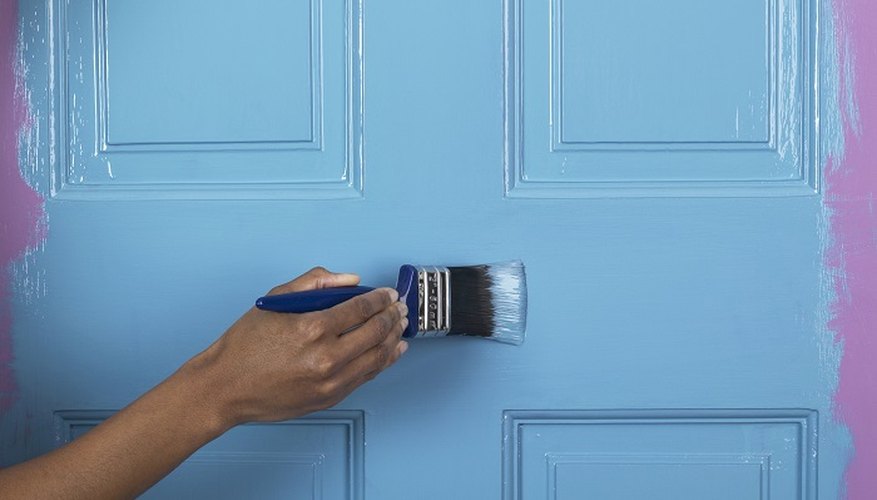Doors take lots of abuse. While the paint may last a long time on other surfaces, doors experience constant, daily use and contact. Grease, dirt and other materials build up on the door and the paint deteriorates. Consequently, doors may look old and worn and this affects the overall appearance of the house. Painting a door is a way of keeping your house looking new and fresh. Hardwood doors are the easiest doors to paint, because the wooden surface absorbs the paint much better than aluminium, plastic or metal surfaces.
- While the paint may last a long time on other surfaces, doors experience constant, daily use and contact.
- Hardwood doors are the easiest doors to paint, because the wooden surface absorbs the paint much better than aluminium, plastic or metal surfaces.
Select the paint for the door. In selecting the paint you need to consider the colour and the sheen. Use a good quality latex paint -- 4.5 litres will be sufficient. The door will need at least two coats and maybe three. The degree of sheen ranges from flat, eggshell, satin, semi-gloss to gloss. Anything but a flat sheen is appropriate for the door, because surfaces painted with flat paint are difficult to clean. If the door is an exterior door, use exterior latex paint. Exterior paint may be used for both sides of the door. Use interior latex paint for inside doors.
Remove and protect the hardware. Place a small tarpaulin sheet or piece of cardboard under the door. Remove hardware such as door knobs and locks. The hardware is usually secured to the door with Phillips-head screws. Protect the hinges with painter's tape.
Sand the door. If the door has been painted before and the old paint is peeling it will be necessary to knock the old paint off with a putty knife. Sanding the door roughens the surface, which allows the paint to adhere better. Start with medium-grit sandpaper and then go over the surface once more with fine-grit sandpaper. Wipe the surface with a clean rag to remove the dust.
- Remove and protect the hardware.
- Wipe the surface with a clean rag to remove the dust.
Apply a primer coat. Use a good quality latex primer. Begin by painting the edges with a trim brush. Painters refer to this as "cutting in." The idea is to cut in the areas where the roller will be unable to reach. If the door is panelled, cut in the edges around the panel as well. Pay attention for drips and runs that may form. Use a full-size or half-size roller, depending on the door design, to prime the door. Pour the primer in a paint tray and dip the roller in the tray and apply the primer. Once you have finished, inspect the door for missed spots, heavy spots and drip. Allow the primer to dry. Most latex primers dry in four to five hours depending on humidity.
- Use a good quality latex primer.
- Once you have finished, inspect the door for missed spots, heavy spots and drip.
Paint the door. Follow the same procedure used for priming the door but don't use the same roller and brush. Cut the door in and then roll it. Use long strokes on the edges and roll the full length of the door with the roller. Allow two to three hours for the first coat to dry and then apply a second coat. Inspect the door after the second coat dries and determine if it needs a third coat.
